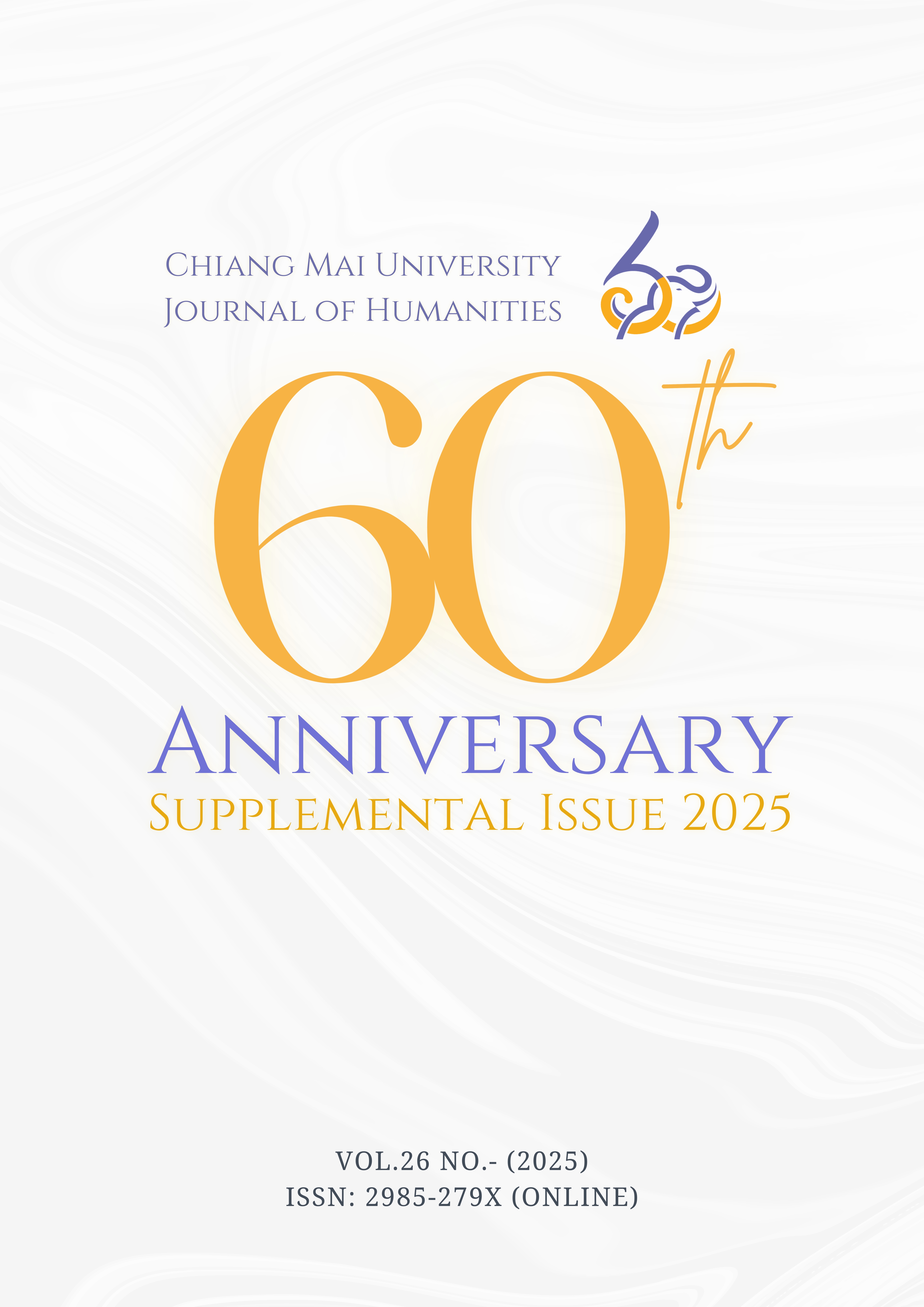The Emergence of A Child of the Northeast in the Capitalist World-Economy: Reading Isan/Thai Literature as World Literature
Main Article Content
บทคัดย่อ
This research article offers a mode of reading that challenges a parochial view of Kampoon Boontawee’s A Child of the Northeast (1976) as a repository of authentic Isan culture. Combining the theory of world literature by the Warwick Research Collective with the concepts of the bildungsroman and chronotope by M. M. Bakhtin, it argues that the novel’s coming-of-age narrative registers the child protagonist’s transition from a predominantly subsistence economy to the modern capitalist world-system, where he aspires to become a member of the bourgeoisie. In the novel’s chronotopic design, the formation of the child of the Northeast is mapped onto the development of Siam/Thailand as a capitalist society. Such a mapping culminates in the protagonist’s heartfelt recitation of a famous Thai verse, “Knowledge as Commodity,” which marks not only the integration of Siam/Thailand into the capitalist world-economy but also the uneven development in Siam/Thailand.
Article Details

อนุญาตภายใต้เงื่อนไข Creative Commons Attribution-NonCommercial-NoDerivatives 4.0 International License.
เอกสารอ้างอิง
Amoko, A. (2009). Autobiography and bildungsroman in African literature. In F. A. Irele (Ed.),
The Cambridge companion to the African novel (pp. 195-208). Cambridge University Press.
Anderson, B. (2006). Imagined communities: Reflections on the origin and spread of nationalism
Verso.
Anu-an, P. (2003). Thai Isan folk wisdoms in the literature of the national artist and Isan sage,
Khamphun Bunthawi” [ภูมิปัญญาไทยอีสานในวรรณกรรมของคำพูน บุญทวี ศิลปินแห่งชาติ “ปราชญ์อีสาน”].
In L. Charoensitthichai (Ed.), “Isan sage” Khamphun Bunthawi [“ปราชญ์อีสาน” คำพูน บุญทวี] (pp. 171-189). Poisian.
Baker, C. (2005). Afterword. In N. Eoseewong, Pen and sail: Literature and history in early
Bangkok (C. Baker, Trans.) (pp. 361-384). Silkworms Books. (Original work published 1982)
Bakhtin, M. M. (1986). The bildungsroman and its significance in the history of realism (toward
a historical typology of the novel). In C. Emerson & M. Holquist (Eds.), Speech genres & other late essays (pp. 10-59). University of Texas Press.
Bakhtin, M. M. (2008). Forms of time and of the chronotope in the novel. In C. Emerson & M.
Holquist (Eds.), The Dialogic imagination (pp. 84-258). University of Texas Press.
Boontawee, K. (1988). A child of the Northeast (S. F. Kepner, Trans.). Duang Kamol. (Original
work published 1976)
Bunthawi, K. (2009a). Author’s preface [คำนำของผู้ประพันธ์]. In K. Bunthawi, A child of the
Northeast [ลูกอีสาน]. (pp. 7-8). Poisian.
Bunthawi, K. (2009b). A child of the Northeast [ลูกอีสาน]. Poisian.
Damrosch, D. (2003). What is world literature?. Princeton University Press.
Damrosch, D. (2014) Introduction: World literature in theory and practice. In D. Damrosch
(Ed.), World literature in theory (pp. 1-11). Wiley-Blackwell.
D’haen, T. (2012). The Routledge concise history of world literature. Routledge.
Fabian, J. (1983). Time and other: How anthropology makes its object. Columbia University
Press.
Eoseewong, N. (2005). Pen and sail: Literature and history in early Bangkok (C. Baker, Trans.).
Silkworms Books. (Original work published 1982)
Grabowsky, V. (1995). The Isan up to its integration into the Siamese state. In V. Grabowsky
(Ed.), Regions and national integration in Thailand 1892-1992 (pp. 107-129). Harrassowitz.
Harrison, R. V. Introduction: Theoretical f(r)ictions: Cultures of criticism, modes of colonialism
and Thai literary studies. In R. V. Harrison (Ed.), Disturbing conventions: Decentering Thai literary cultures (pp. 1-33). Rowman & Littlefield International.
Jackson, P. A. (2010). The ambiguities of semicolonial power in Thailand. In R. V. Harrison, &
P. A. Jackson (Eds.), The ambiguous allure of the West: Traces of the colonial in Thailand (pp. 37-56). Hong Kong University Press.
Jeamteerasakul, S. (2006). History of Thailand’s current national anthem [ความเป็นมาของเพลงชาติ
ไทยปัจจุบัน]. Thammasat Journal, 27(1), 2-102.
Kepner, S. F. (1996). The Lioness in bloom: Modern Thai fiction about women. University of
California Press.
Keyes, C. F. (1995). Hegemony and resistance in northeastern Thailand. In V. Grabowsky (Ed.),
Regions and national integration in Thailand 1892-1992 (pp. 154-182). Harrassowitz.
Keyes, C. F. (2012). Cosmopolitan’ villagers and populist democracy in Thailand. South East
Asia Research, 20(3), 343–360. doi: 10.5367/sear.2012.0109
Kittiarsa, P. (2014). Isan becoming: Agrarian change and the sense of mobile community in
Northeastern Thailand [สู่วิถีอีสานใหม่]. Wiphasa.
Kongsirirat, S. (2013). “Knowledge as commodity”: The unrecognized literature of Nai Mee
[“วิชาเหมือนสินค้า”: วรรณกรรมของนายมีที่ไม่เป็นที่รู้จัก]. Journal of Humanities Naresuan University, 10(1), 23-38.
Lamyodmakpol, T. (2010). A child of the Northeast: Pure power of literature [ลูกอีสาน อำนาจ
บริสุทธิ์ของวรรณกรรม]. In Novels: Criticism of thirteen novels by national artists in literature [นวนิยาย: บทวิจารณ์นวนิยายสิบสามเรื่องของศิลปินแห่งชาติสาขาวรรณศิลป์] (pp. 133-145). Praew.
Lysa, H. (1984). Thailand in the nineteenth century: Evolution of the economy and society.
The Institute of Southeast Asian Studies.
Moretti, F. (2000). The way of the world: The bildungsroman in European culture. Verso.
Pattarakulvanit, C., Tran, B., Chotiudompant, S., & Harrison, R. V. (2014). Afterward – part 1:
Thai literature as world literature. In R. V. Harrison (Ed.), Disturbing conventions: Decentering Thai literary cultures (pp. 233-239). Rowman & Littlefield International.
Prachakul, N. (2009a). Luk Isan (a child of the Northeast): Techniques of composition and issues
of ethnic culture [ลูกอีสาน เทคนิคการประพันธ์กับประเด็นเรื่องเชื้อชาติวัฒนธรรม]. In Reading against the grain, reading against the current of thought [ยอกอักษร ย้อนความคิด] (Vol. 1, pp. 33-40). Arn.
Prachakul, N. (2009b). What’s there in a child of the Northeast? [มีอะไรในลูกอีสาน]. In Reading
against the grain, reading against the current of thought [ยอกอักษร ย้อนความคิด] (Vol. 1, pp. 43-50). Arn.
Prachakul, N. (2014). Luk Isan (A Child of the Northeast): Techniques of composition and issues
of ethnic culture (R. V. Harrison, Trans). In R. V. Harrison (Ed.), Disturbing conventions: Decentering Thai literary cultures (pp. 105-110). Rowman & Littlefield International. Original work published 1998.
Prasansak, R. (2020). A distant reading of Khamphun Bunthawi’s Luk Isan (A Child of the
Northeast) as world literature. Journal of Letters, 49(2), 1–20.
Rungrat, P. (2003). Three gratifications in the work of the national artist and the first S.E.A.
award winner Kamphum Bunthawi [สามอิ่มในงานของคำพูน บุญทวี ศิลปินแห่งชาติเจ้าของรางวัลวรรณกรรมซีไรต์คนแรก]. In L. Charoensitthichai (Ed.), “Isan sage” Khamphun Bunthawi [“ปราชญ์อีสาน” คำพูน บุญทวี] (pp. 190-204). Poisian.
Skinner, G. W. (1957). Chinese society in Thailand: An analytical history. Cornell University
Press.
Viraphol, S. (2014). Tribute and profit: Sino-Siamese trade, 1652-1853. Silkworm.
Warwick Research Collective. (2015). Combined and uneven development: Towards a new
theory of world-literature. Liverpool University Press.
Wimuttikosol, S. (2020). Man-Tiger and the Thai readers: A case for peripheral readership of
world literature. Journal of Human Sciences, 21(2), 46–63.
Winichakul, T. (2000). The other within: Ethnography and travel literature from Bangkok
metropolis to its periphery in the late nineteenth century. In A. Turton (Ed.), Siam Civility and Savagery: Social identity in Tai States (pp. 38-62). Curzon.
Winichakul, T. (2014). Forward: Decentering Thai studies. In R. V. Harrison (Ed.), Disturbing
conventions: Decentering Thai literary cultures (pp. xiii-xix). Rowman & Littlefield International.


